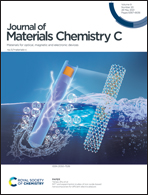Disilane-bridged architectures with high optical transparency for optical limiting†
Abstract
A novel tetraphenylethylene (TPE) architecture that makes use of a disilane bridge was developed to successfully prepare organic optical power limiting (OPL) materials with high transparency. The σ-bridged TPE derivatives exhibit enhanced solid-state emission efficacies up to 4 times that of TPE. Due to the unique σ-electron delocalization, the incorporated Si–Si bridge gives rise to intense nonlinear optics (NLO) properties. These compounds show favorable optical transparency in the visible region, since the σ–π interaction has a relatively minor effect on the absorption properties of TPE. The poly(bisphenol A carbonate) (PBC) thin films of disilane-bridged compounds exhibit significant reverse saturable absorbance (RSA) responses during Z-scan measurements at 532 nm. In contrast, negligible OPL properties were observed in tetrahydrofuran (THF) solution and when a PBC thin film was prepared with TPE. The disilane-bridged molecular system represents a novel and easily prepared architecture for the construction of solid-state optical limiting materials.

- This article is part of the themed collection: Journal of Materials Chemistry C HOT Papers


 Please wait while we load your content...
Please wait while we load your content...